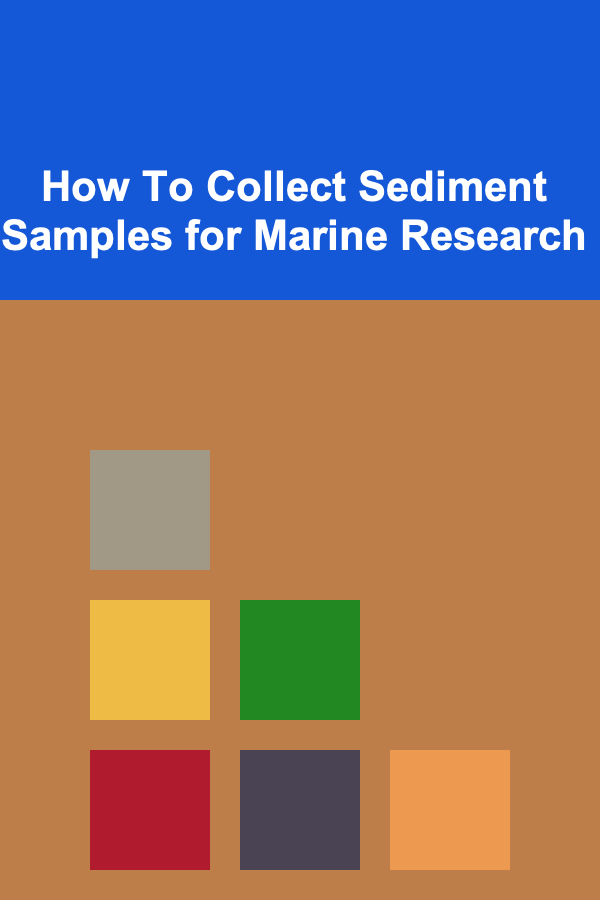
How To Collect Sediment Samples for Marine Research
ebook include PDF & Audio bundle (Micro Guide)
$12.99$6.99
Limited Time Offer! Order within the next:

Sediment sampling is a crucial method in marine research, offering valuable insights into the history of the ocean, its ecosystems, and the various environmental changes that have occurred over time. Marine sediments can reveal information about ocean currents, climate change, pollution, and the behavior of marine species. Collecting these samples involves careful planning, precise techniques, and an understanding of the research goals. In this article, we will explore the process of collecting sediment samples for marine research, discussing the techniques, tools, and considerations needed for successful sample collection.
Introduction to Marine Sediment Sampling
Marine sediment refers to the particles that accumulate on the ocean floor, including materials from both land and the ocean itself. These materials vary widely in size and composition, from tiny clay particles to larger sand grains and shells. Marine sediments are dynamic, influenced by a variety of processes such as currents, tidal movements, biological activity, and geological forces.
Collecting sediment samples from the marine environment allows scientists to study the composition, structure, and properties of these materials. Marine sediments play an essential role in understanding the past, present, and future of marine ecosystems and environmental conditions. For example, sediment cores can provide records of past ocean temperatures, salinity, and even carbon dioxide levels. By analyzing these samples, researchers can gain critical insights into long-term environmental trends and identify areas that may be at risk due to pollution or climate change.
Types of Marine Sediment
Before diving into the techniques for collecting sediment samples, it's important to understand the different types of sediments that are found on the ocean floor. These can be classified based on their origin, particle size, and composition.
-
Terrigenous Sediments
These sediments come from land sources, primarily through rivers, wind, and glaciers. They are often composed of fine particles such as clay and silt, as well as larger grains like sand and gravel. Terrigenous sediments are typically found near the coast and continental shelf, but can also extend to deep ocean basins.
-
Biogenic Sediments
These sediments are derived from the remains of marine organisms such as plankton, coral, and shellfish. The primary components of biogenic sediments are calcium carbonate and silica, which make up the shells and skeletons of marine organisms. These sediments are typically found in areas of high biological productivity, such as upwelling zones or coral reefs.
-
Hydrogenous Sediments
Hydrogenous sediments are precipitated directly from seawater. These include minerals like manganese nodules and phosphorites that form when dissolved minerals in seawater precipitate out of solution due to changes in temperature, pressure, or chemical composition. These sediments are less common but are of great interest to researchers studying deep-sea processes.
-
Cosmogenous Sediments
These are extraterrestrial particles, such as meteoritic dust and interplanetary materials, that fall to Earth and accumulate in marine sediments. Although these particles are rare, their presence provides useful information about the Earth's exposure to outer space debris.
Each type of sediment provides valuable clues to the processes shaping the marine environment, and understanding these types helps researchers design effective sampling strategies.
Tools and Equipment for Sediment Sampling
Collecting sediment samples from the marine environment requires specialized equipment designed to retrieve sediments from the ocean floor without disturbing or contaminating the sample. Several tools and techniques are used depending on the depth of the water, the nature of the sediment, and the research objectives.
1. Grab Samplers
Grab samplers are one of the most commonly used tools for sediment collection. These devices are designed to "grab" a sample of sediment from the ocean floor. They typically consist of a set of jaws or scoops that are lowered to the seabed and then closed to capture the sediment. Grab samplers are ideal for shallow-water surveys and can collect surface sediments or samples from a specific depth range.
Some of the most popular grab samplers include:
- Van Veen Grab: This sampler is designed with two jaws that close around a sediment sample when it reaches the ocean floor. It is widely used for collecting soft to medium sediments, such as mud and sand.
- Pettersson Grab: This is another type of grab sampler, often used for soft sediments. It operates similarly to the Van Veen but has a more refined design to minimize contamination during sample collection.
- Clamshell Sampler: This type of grab sampler features two scoops shaped like the halves of a clam shell. The scoops close to collect sediment, making it suitable for both surface and deeper sediment samples.
2. Corers
Corers are used to collect continuous, undisturbed sediment cores from the ocean floor. These cores allow scientists to examine vertical profiles of the sediment, revealing information about sediment layers, historical climate patterns, and biogeochemical processes over time. Corers are typically used in deeper waters where grab samplers might not be effective.
Some of the most commonly used corers are:
- Gravity Corer: This tool consists of a heavy weight attached to a long tube that is lowered to the ocean floor. The weight helps push the corer into the sediment, allowing it to collect a core sample. Gravity corers are often used for collecting deep-sea sediment samples.
- Piston Corer: Similar to the gravity corer, but with an added piston mechanism to provide additional force to penetrate deeper sediments. This is especially useful for obtaining long cores in soft sediments.
- Box Corer: A large, box-shaped device that is lowered to the ocean floor and collects sediment from a defined area. Box corers are particularly useful for collecting samples of fine-grained sediments and for studying the structure of the sediment layers.
3. Sediment Traps
Sediment traps are used to collect falling particles from the water column. They are often deployed for longer periods to monitor the accumulation of particulate matter, including plankton, organic material, and detritus. Sediment traps are usually suspended in the water column at specific depths and allow researchers to observe sediment deposition over time.
4. Other Tools
In addition to grab samplers, corers, and sediment traps, other tools may be used in marine sediment research. These include:
- Rov Systems (Remotely Operated Vehicles): ROVs can be equipped with samplers and cameras to collect sediment samples from remote or difficult-to-access areas. They are commonly used for deep-sea sampling.
- Multibeam Echo Sounders: These devices help map the seabed in high resolution and provide valuable information about the sediment distribution and the structure of the ocean floor.
- CTD (Conductivity, Temperature, and Depth Sensors): While primarily used to measure water properties, CTD devices can also assist in determining the appropriate depth for sediment sampling.
Steps for Collecting Sediment Samples
Once the appropriate equipment is selected, there are several key steps to follow to ensure that sediment samples are collected effectively and accurately.
1. Planning and Site Selection
The first step in sediment sampling is careful planning and site selection. Researchers must identify the research objectives and select the sampling sites accordingly. Factors to consider include:
- Depth: Deeper sites may require specialized equipment like gravity or piston corers, while shallow areas may be suitable for grab samplers.
- Sediment Type: The composition and texture of the sediment will influence the choice of tool. For example, muddy or soft sediments may require a different approach than rocky or coarse sediments.
- Environmental Conditions: Strong currents, high sedimentation rates, or difficult access (such as deep-sea trenches) may require additional considerations for equipment and sampling methods.
2. Deploying the Sampling Equipment
Once the sampling site has been identified, the appropriate tool is deployed to the ocean floor. This typically involves lowering the equipment from a research vessel, which may be equipped with a crane or winch system. In deeper water, ROVs may be used to assist with deployment and retrieval.
3. Sampling and Collection
Once the sampling equipment reaches the seabed, the sample is collected. Depending on the tool, this may involve closing a grab sampler, driving a corer into the sediment, or allowing a sediment trap to collect particles over time.
4. Retrieving the Samples
After the sample has been collected, the equipment is retrieved, either manually or through automated systems. In the case of sediment cores, great care must be taken to ensure that the sample remains intact and undisturbed. Often, core samples are stored in specialized containers or liners to prevent contamination and preserve the integrity of the sediment layers.
5. Sample Preservation and Transport
Sediment samples must be carefully preserved to avoid contamination and to maintain their original properties. Samples are typically stored in cool, dark conditions to prevent biological or chemical degradation. In some cases, preservatives or stabilizing agents are used to prevent further changes in the sample's composition.
Once preserved, the samples are transported to the laboratory for further analysis. During this phase, detailed studies can be performed to identify the chemical, physical, and biological properties of the sediment.
Challenges in Sediment Sampling
While sediment sampling is a valuable tool for marine research, it comes with its own set of challenges. Some of the common difficulties include:
- Contamination: Preventing contamination of the sample is crucial for ensuring accurate results. Any contact with foreign materials, such as handling with dirty equipment or exposure to air, can alter the sediment's composition.
- Sample Loss: In some cases, retrieving a sample from the ocean floor can be difficult, especially in deep-sea environments or areas with strong currents. Loss of sample integrity can also occur if the sediment is disturbed during collection.
- Accessibility: Deep-sea environments and remote regions of the ocean can be difficult to access, requiring specialized equipment like ROVs or deep-diving submersibles.
Conclusion
Marine sediment sampling is a complex yet essential process in oceanographic and environmental research. By carefully selecting the appropriate tools and techniques, researchers can gather valuable information that helps us understand marine ecosystems, climate change, and the history of our planet's oceans. Whether studying deep-sea cores or shallow coastal sediments, each sample provides unique insights into the world beneath the waves.

How to Choose the Right Materials for Your Home Renovation Project
Read More
How to Create a Peaceful Bedroom Environment through Organization
Read More
How to Develop a Complete Home Camera System That Meets Your Needs
Read More
How to Plan a Pool Party at Home for the Ultimate Summer Bash
Read More
How to Reclaim Space in Your Kitchen with Pull-Out Pantry Drawers
Read More
How to Use Color Coding for Easy Photo Album Organization
Read MoreOther Products

How to Choose the Right Materials for Your Home Renovation Project
Read More
How to Create a Peaceful Bedroom Environment through Organization
Read More
How to Develop a Complete Home Camera System That Meets Your Needs
Read More
How to Plan a Pool Party at Home for the Ultimate Summer Bash
Read More
How to Reclaim Space in Your Kitchen with Pull-Out Pantry Drawers
Read More